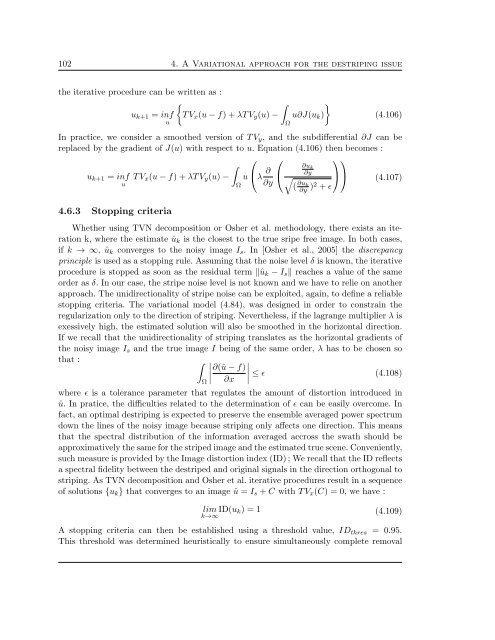Th`ese Marouan BOUALI - Sites personnels de TELECOM ParisTech
Th`ese Marouan BOUALI - Sites personnels de TELECOM ParisTech
Th`ese Marouan BOUALI - Sites personnels de TELECOM ParisTech
You also want an ePaper? Increase the reach of your titles
YUMPU automatically turns print PDFs into web optimized ePapers that Google loves.
102 4. A Variational approach for the <strong>de</strong>striping issue<br />
the iterative procedure can be written as :<br />
u k+1 = inf<br />
u<br />
{<br />
TV x (u − f)+λT V y (u) −<br />
∫<br />
Ω<br />
}<br />
u∂J(u k )<br />
(4.106)<br />
In practice, we consi<strong>de</strong>r a smoothed version of TV y , and the subdifferential ∂J can be<br />
replaced by the gradient of J(u) with respect to u. Equation (4.106) then becomes :<br />
⎛ ⎛<br />
⎞⎞<br />
∫<br />
u k+1 = inf TV x (u − f)+λT V y (u) − u ⎝λ ∂ ∂u k<br />
⎝<br />
∂y<br />
√ ⎠⎠ (4.107)<br />
u<br />
Ω ∂y<br />
( ∂u k<br />
∂y )2 + ɛ<br />
4.6.3 Stopping criteria<br />
Whether using TVN <strong>de</strong>composition or Osher et al. methodology, there exists an iteration<br />
k, where the estimate û k is the closest to the true sripe free image. In both cases,<br />
if k →∞, û k converges to the noisy image I s . In [Osher et al., 2005] the discrepancy<br />
principle is used as a stopping rule. Assuming that the noise level δ is known, the iterative<br />
procedure is stopped as soon as the residual term ‖û k − I s ‖ reaches a value of the same<br />
or<strong>de</strong>r as δ. In our case, the stripe noise level is not known and we have to relie on another<br />
approach. The unidirectionality of stripe noise can be exploited, again, to <strong>de</strong>fine a reliable<br />
stopping criteria. The variational mo<strong>de</strong>l (4.84), was <strong>de</strong>signed in or<strong>de</strong>r to constrain the<br />
regularization only to the direction of striping. Nevertheless, if the lagrange multiplier λ is<br />
exessively high, the estimated solution will also be smoothed in the horizontal direction.<br />
If we recall that the unidirectionality of striping translates as the horizontal gradients of<br />
the noisy image I s and the true image I being of the same or<strong>de</strong>r, λ has to be chosen so<br />
that :<br />
∫<br />
∂(û − f)<br />
∣ ∂x ∣ ≤ ɛ (4.108)<br />
Ω<br />
where ɛ is a tolerance parameter that regulates the amount of distortion introduced in<br />
û. In pratice, the difficulties related to the <strong>de</strong>termination of ɛ can be easily overcome. In<br />
fact, an optimal <strong>de</strong>striping is expected to preserve the ensemble averaged power spectrum<br />
down the lines of the noisy image because striping only affects one direction. This means<br />
that the spectral distribution of the information averaged accross the swath should be<br />
approximatively the same for the striped image and the estimated true scene. Conveniently,<br />
such measure is provi<strong>de</strong>d by the Image distortion in<strong>de</strong>x (ID) ; We recall that the ID reflects<br />
a spectral fi<strong>de</strong>lity between the <strong>de</strong>striped and original signals in the direction orthogonal to<br />
striping. As TVN <strong>de</strong>composition and Osher et al. iterative procedures result in a sequence<br />
of solutions {u k } that converges to an image û = I s + C with TV x (C) = 0, we have :<br />
lim<br />
k→∞ ID(u k)=1 (4.109)<br />
A stopping criteria can then be established using a threshold value, ID thres = 0.95.<br />
This threshold was <strong>de</strong>termined heuristically to ensure simultaneously complete removal















